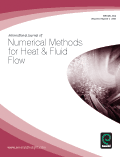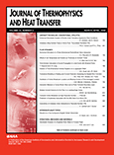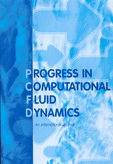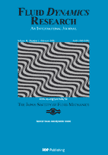
INTERNATIONAL JOURNAL OF NUMERICAL METHODS FOR HEAT & FLUID FLOW
Scope & Guideline
Pioneering Innovative Numerical Techniques for Engineers.
Introduction
Aims and Scopes
- Numerical Methods Development:
The journal emphasizes the development and refinement of numerical techniques, such as finite element methods, computational fluid dynamics, and lattice Boltzmann methods, to solve complex heat and fluid flow problems. - Heat Transfer Analysis:
A core area of focus is the analysis of heat transfer mechanisms, including conduction, convection, and radiation in various systems, particularly involving nanofluids and hybrid materials. - Fluid Dynamics Research:
Research articles often explore fluid dynamics phenomena, including magnetohydrodynamics, bioconvection, and non-Newtonian fluid behaviors, contributing to a deeper understanding of fluid motion under various conditions. - Application of Advanced Computational Techniques:
The journal encourages the application of advanced computational techniques, including machine learning and artificial intelligence, to enhance predictive modeling and optimization in thermal and fluid systems. - Multi-Scale and Multi-Physics Modeling:
A unique contribution of the journal is its focus on multi-scale and multi-physics modeling approaches that integrate various physical phenomena, such as thermal, mechanical, and chemical interactions, to address real-world engineering challenges.
Trending and Emerging
- Hybrid Nanofluids Research:
Research on hybrid nanofluids is on the rise, focusing on their thermal performance and applications in various engineering systems, reflecting the growing interest in enhancing heat transfer efficiency. - Machine Learning Applications:
There is a marked increase in studies applying machine learning techniques to predict and optimize heat and fluid flow phenomena, showcasing the integration of artificial intelligence in computational fluid dynamics. - Magnetohydrodynamics (MHD) Studies:
MHD is gaining traction, particularly in the context of nanofluids and their interactions under magnetic fields, indicating a trend towards exploring advanced materials and their behaviors. - Multi-Physics and Coupled Systems Analysis:
Emerging themes involve multi-physics analyses that couple various phenomena, such as thermal, fluid, and structural interactions, to solve complex engineering problems more effectively. - Entropy Generation and Thermodynamic Optimization:
Research focusing on entropy generation analyses and thermodynamic optimization strategies is becoming increasingly relevant, as researchers seek to enhance energy efficiency in thermal systems.
Declining or Waning
- Classical Heat Transfer Methods:
There seems to be a waning interest in traditional heat transfer methodologies that do not incorporate modern computational techniques or hybrid approaches, as researchers lean towards more innovative solutions. - Simplistic Fluid Flow Models:
Basic models of fluid flow, which do not account for complex interactions such as non-Newtonian behaviors or multi-phase systems, are becoming less prevalent as the demand for more sophisticated analyses increases. - Static Analyses without Computational Support:
Research focused solely on static analyses without incorporating computational elements is declining, as more studies aim for dynamic simulations that reflect real-world conditions. - Low-Temperature Applications:
There has been a noticeable decrease in studies focusing on low-temperature heat transfer applications, likely due to a shift towards high-performance systems and extreme conditions. - Limited Nanofluid Studies:
While nanofluids were a significant topic of interest, the novelty is fading, and there appears to be a decrease in studies that do not explore innovative applications or new formulations.
Similar Journals

JOURNAL OF THERMOPHYSICS AND HEAT TRANSFER
Advancing the Frontiers of Heat Transfer KnowledgeJOURNAL OF THERMOPHYSICS AND HEAT TRANSFER, published by the American Institute of Aeronautics and Astronautics, serves as a vital platform for the dissemination of cutting-edge research in the fields of thermophysics and heat transfer. With an ISSN of 0887-8722 and an E-ISSN of 1533-6808, this journal has been pivotal in enhancing our understanding of heat transfer mechanisms since its inception in 1987, continuing through 2024. It occupies a noteworthy position in various academic categories, boasting Q2 rankings in both Fluid Flow and Transfer Processes and Mechanical Engineering, reflecting its significant contribution to the engineering and physical sciences community. Although it currently does not offer Open Access options, the journal’s repository of rigorous peer-reviewed articles remains accessible to researchers, professionals, and students eager to expand their knowledge and apply innovative findings in aerospace, condensed matter physics, and planetary sciences. Emphasizing both theoretical and experimental approaches, the JOURNAL OF THERMOPHYSICS AND HEAT TRANSFER remains an indispensable resource for advancing the frontiers of engineering and applied sciences.

Journal of Thermal Science
Transforming thermal science into practical solutions.Journal of Thermal Science is a prestigious academic publication dedicated to the field of thermal science and its applications. Published by SPRINGER, this journal has been at the forefront of knowledge dissemination since its inception in 1992 and continues to provide a platform for researchers and professionals to share their innovative findings through high-quality peer-reviewed articles. With its ISSN 1003-2169 and E-ISSN 1993-033X, the journal covers a diverse array of topics related to thermal processes, materials, and engineering, significantly contributing to advancements in Condensed Matter Physics. In the latest rankings, it holds a commendable Q2 category in the 2023 quartiles, further highlighting its relevance with a Scopus ranking of #183/434 in its field, placing it in the top 57th percentile. While currently not offering open access, the journal strives to bridge the gap between theory and practice, making substantial impacts on both academia and industry. Its continued exploration of cutting-edge research ensures that it remains a key resource for students and professionals looking to expand their knowledge and foster innovation in thermal sciences.

Computational Thermal Sciences
Unlocking New Insights in Computational Thermal DynamicsComputational Thermal Sciences, an esteemed journal published by BEGELL HOUSE INC, presents cutting-edge research at the intersection of computational mathematics, energy engineering, and fluid dynamics. With an ISSN of 1940-2503 and an E-ISSN of 1940-2554, this journal aims to disseminate high-quality research articles, reviews, and methodologies that improve our understanding of thermal processes and their applications. Renowned for its solid impact in the field, it holds a Q3 ranking in multiple categories including Computational Mathematics and Energy Engineering for 2023. As the field evolves, the journal continues to play a pivotal role in bridging theoretical research with practical innovations, thereby catering to a diverse audience of researchers, professionals, and students. Although it operates on a subscription model, the journal ensures accessibility to significant contributions in thermal sciences from 2009 to 2024, fostering an environment of knowledge sharing and collaboration.

Case Studies in Thermal Engineering
Elevating Knowledge in Thermal Engineering ExcellenceCase Studies in Thermal Engineering, published by ELSEVIER, stands as a premier platform for innovative research and analysis in the field of thermal engineering since its inception in 2013. With a robust Open Access model, this journal ensures that groundbreaking findings in fluid flow and transfer processes are readily accessible to a global audience, fostering collaboration and knowledge sharing across disciplines. Situated in the United Kingdom, the journal boasts an impressive impact factor, reflecting its status in the first quartile (Q1) for both engineering (miscellaneous) and fluid flow and transfer processes, as noted in the latest Scopus rankings. Researchers and professionals alike recognize its significance, ranking 9th out of 96 in Chemical Engineering and achieving a notable 91st percentile in its category. By publishing high-quality case studies, the journal aims to advance understanding and applications of thermal engineering principles, making it an essential resource for those looking to stay at the forefront of this dynamic field.

APPLIED THERMAL ENGINEERING
Transforming energy challenges into engineering solutions.Applied Thermal Engineering is a leading international journal dedicated to the field of thermal engineering, published by Pergamon-Elsevier Science Ltd. With an impressive impact factor indicating its significance in the academic community, this journal focuses on innovative research and developments related to energy engineering, fluid flow, and transfer processes, as well as manufacturing and mechanical engineering. Being indexed in top quartiles (Q1) across multiple categories, it ranks exceptionally well on platforms like Scopus, ensuring that contributors reach a wide and relevant audience. The journal supports both open access and subscription options, promoting the dissemination of vital research findings from 1996 to 2024. With its commitment to advancing the discipline and implementing rigorous peer-review processes, Applied Thermal Engineering serves as an essential resource for researchers, industry professionals, and students aiming to stay abreast of the latest advancements and applied methodologies in thermal science.

INTERNATIONAL JOURNAL OF HEAT AND FLUID FLOW
Contributing to Excellence in Mechanical Engineering ResearchFounded in 1979, the INTERNATIONAL JOURNAL OF HEAT AND FLUID FLOW is a premier publication in the fields of mechanical engineering, fluid dynamics, and heat transfer, published by Elsevier Science Inc. With an impressive impact factor and ranking in the Q1 category for Mechanical Engineering and Q2 for Condensed Matter Physics and Fluid Flow and Transfer Processes, this journal is highly regarded for its rigorous peer-reviewed articles that contribute significantly to the advancement of knowledge in these critical areas. Researchers, professionals, and students can access cutting-edge studies that explore the intricacies of thermal and fluid systems, ensuring they stay at the forefront of scientific exploration. The Scopus rankings further affirm its role as a leading source of impactful research, with significant placements in crucial academic categories. Join an active community of scholars committed to innovation and excellence in the exploration of heat and fluid flow phenomena.

Mechanika
Innovating Research in Mechanics and BeyondMechanika is a prominent open-access journal published by Kaunas University of Technology in Lithuania, with an ISSN of 1392-1207 and E-ISSN 2029-6983. Since its transition to open access in 2007, the journal has successfully facilitated the dissemination of vital research findings within the field of condensed matter physics, carving a niche for itself in a competitive academic landscape. Despite currently being categorized in the Q4 quartile for its impact in this area, Mechanika aims to foster advancements by providing a platform for innovative studies, reviews, and applications. As researchers, professionals, and students engage with its content, they will find an array of studies that push the boundaries of understanding in mechanics and related disciplines. Situated in the vibrant academic milieu of Kaunas, Mechanika is committed to quality, accessibility, and fostering scientific dialogue among the global academic community.

PROGRESS IN COMPUTATIONAL FLUID DYNAMICS
Innovating Computational Approaches for Fluid DynamicsPROGRESS IN COMPUTATIONAL FLUID DYNAMICS, published by InderScience Enterprises Ltd, is a vital journal in the realms of Computer Science Applications and Condensed Matter Physics. Established in 2001, this journal serves as a platform for disseminating innovative research findings and technological advancements in computational fluid dynamics, targeting both theoretical and applied aspects. With a current impact factor positioning it in the Q4 quartile for its fields, it captures a wide array of topics including numerical methods, simulation techniques, and real-world fluid dynamics applications, fostering dialogue among researchers, practitioners, and educators alike. Although it does not provide Open Access options, it remains an important resource for those investigating fluid dynamics phenomena. As it continues to evolve through 2024, PROGRESS IN COMPUTATIONAL FLUID DYNAMICS is positioned to contribute significantly to the scientific community, addressing core challenges while promoting collaboration and knowledge exchange.

Frontiers in Heat and Mass Transfer
Bridging Gaps in Scientific UnderstandingFrontiers in Heat and Mass Transfer is a premier open-access journal published by TECH SCIENCE PRESS that focuses on the interdisciplinary field of heat and mass transfer. Established in 2010, this journal has been pivotal in disseminating high-quality research aimed at advancing the understanding of energy and material transport phenomena. With an impressive commitment to open access, it ensures that all published articles are readily available to researchers, practitioners, and students globally, promoting knowledge sharing and collaboration. The journal currently holds a Q3 ranking in key categories such as Engineering, Materials Science, and Physics and Astronomy, as well as notable positioning in Scopus rankings. With a forward-looking scope extending from 2010 to 2024, Frontiers in Heat and Mass Transfer continues to be an essential platform for innovative research, fostering the development of practical applications across various scientific and engineering domains. We invite you to explore the latest contributions to this evolving field and consider this journal as a vital resource for your academic and professional growth.

FLUID DYNAMICS RESEARCH
Empowering Scholars to Transform Fluid Dynamics KnowledgeFLUID DYNAMICS RESEARCH, published by IOP Publishing Ltd, is a pivotal journal dedicated to advancing the understanding of fluid dynamics through interdisciplinary research that spans several domains including mechanical engineering and physics. With an ISSN of 0169-5983 and E-ISSN 1873-7005, this journal provides a vital platform for researchers aiming to disseminate new findings and theoretical advancements in fluid flow and transfer processes. As of 2023, FLUID DYNAMICS RESEARCH holds a commendable position within the academic community, ranked Q3 in fluid flow and transfer processes, mechanical engineering, and miscellaneous physics and astronomy categories. The journal showcases a diverse array of articles that not only inspire collaboration among professionals and students but also ensure that theoretical and experimental studies are accessible for further development in the field. Operating from the United Kingdom, the journal offers a unique opportunity for scholars worldwide to contribute to the vibrant community dedicated to understanding the complexities of fluid dynamics, even as it anticipates converging its years of research from 1986 to 2024.